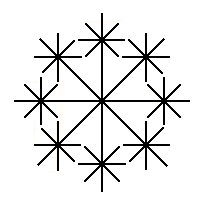by Bok-Nam Park
[Adapted and Re-edited by F. Hriadil]
The wind was sharp and it prodded at the body like a sword wielded by a martial arts adept, stinging but not quite penetrating. A thick fog hung from the boughs of the scraggly pines like a tattered blanket and served to obscure the view of the young traveler who was hurrying along the mountain path. The young traveler had been chosen to deliver an important message to one of the fabled Taoist monasteries on the mountain and his mind was busy with the expectations of his quest. At every turn of the path he strained to catch a glimpse of his destination when with a THUD, he ran clumsily into a tiny old man. Much to the young traveler’s surprise, he was unceremoniously uprooted and plopped onto the ground like an overcooked prune.
Angry, he leapt to his feet and began to berate the old man for his supposed negligence. The old man listened for a while and then dismissed the young traveler. With an insolent wave of his hand and an infuriating smile, he bade the young traveler to be quiet.
The young traveler’s pride was hurt. After all, he said to himself, Am I not the highest student of one of the most revered martial art instructors in this province? At this point, he decided to teach the old man a lesson in etiquette and angrily informed him of this resolve.
The old man smiled with that infuriating smirk again and said, Very well, if you must, but please hurry, I don’t have a lot of time to play. Upon hearing this, the young traveler became even angrier, and without warning he attacked with a punch that had the speed and force of a hurricane. However, the punch never landed, but only flew through the air culminating with a loud pop as it reached its full extension. The old man was gone!
When the punch was initiated, the old man had stepped with extreme precision and speed and was now standing behind the young traveler. The young traveler was perplexed and stood still, trying to decide what to do next. From behind the young traveler the old man spoke. He simply said, Please hurry, I really don’t have much time to play.
Upon hearing the old man’s voice, the young traveler, although visibly shaken, wheeled to face the old man. He launched a tremendously powerful kick toward where the old man was standing only to have it fall on nothing but the memory of the old man standing there with that silly smirk on his face. Again, as he stood transfixed, trying to regain his composure, the old man spoke from behind him. He said, Please young man, please hurry, I really don’t have much time to…
Although Ba Gua Zhang (Pa Kua Chang) is a relatively young art, it is based on natural principles that come directly from ancient Chinese philosophy. These principles, which include Yi Jing (I Ching – Book of Changes), Yin and Yang, and Wu Xing (Wu Hsing – Five Elements), serve to define and balance the art. As such, Ba Gua is an internal Taoist martial discipline that requires a natural balance for completeness and proper practice.
Currently, many people attempt to practice the internal martial arts, such as Ba Gua or Tai Ji Quan (Tai Chi Chuan), in an unbalanced way. They practice the form or the qi gong (chi kung) elements, which are Yin, and leave out the self-defense or martial elements, which are Yang. While it is still a performing art of sorts in this circumstance, it is sadly no longer a complete martial art because, among other things, it has lost its overall balance of Yin and Yang. Ba Gua Zhang, in its truest and purest sense, is a martial art that cannot be separated from its self-defense content. Any attempt to do so is improper and will severely limit the level of proficiency and understanding a practitioner can attain.
In this article, I wish to discuss a very special Stepping Methodology from my system of Ba Gua Zhang. This methodology will allow you to achieve capabilities and results similar to that of the old man illustrated in the above introductory tale. It is called Ba Fang Gen Bu (Eight Direction Rooted Stepping). This Stepping Methodology consists of a sophisticated series of movement patterns or sequences that provide the Ba Gua practitioner with a vast arsenal of direction changes, yielding methods, and turning motions. When executed in a smooth, rapid, and efficient manner, these sequences can be utilized to place the Ba Gua practitioner in a superior attacking or counter-attacking position during any confrontation. Ba Fang Gen Bu can be used in conjunction with the classical Ba Gua Zhang circle walking methods; however, it is normally not a part of the Circle Walking movements or the Nine Stations movements found in most styles of Ba Gua.
Ba Fang Gen Bu is one of the Yang or fighting elements of my system of Ba Gua Zhang. It utilizes and depends upon the same natural principles which balance the art of Ba Gua as a whole. All of these natural principles interact and inter-relate in the proper way to create a methodology that is complete, symmetrical, and balanced.
In Ba Feng Gen Bu, the stepping directions arise from the Yi Jing. This is illustrated in Figure 1. By drawing lines between opposite Gua (Kua), we produce eight directions.

If we can imagine standing at the point where all the lines intersect at the center and move forward along the front line with any step, Ba Fang Gen Bu opens up a new set of possible directions and angles through which to advance or retreat to continue an attack, a defense, or a counter-attack. This is illustrated in Figure 2.

Subtle weight changes and control between the front and back feet are required to execute the stepping methods correctly. These weight changes must also adhere to the exact same underlying natural principles discussed above because they, in fact, make it possible for the Ba Gua practitioner to execute the many types of steps and sequences that are present within Ba Fang Gen Bu. These subtle weight changes, when done properly, create the root that helps to maintain strength and balance throughout the stepping process — from the starting stance through to the concluding posture.
In Figure 3, by applying the principle of Yin and Yang, we continue to expand upon the initial pattern provided by the Yi Jing. The additional sequences of directions and angles shown are called the Ssu Fang Gen Bu (Four Direction Rooted Steps). This illustrates how the principles always interact and inter-relate to produce a balanced result.

If we carry the Yi Jing and Yin/Yang principles through to full completion, we produce the 64 (8 x 8) stepping patterns or sequences shown in Figure 4. Without the inter-relationship and interaction between the underlying natural principles, Ba Fang Gen Bu would not be balanced and thus could not truly be a part of Ba Gua Zhang.

Ba Fang Gen Bu does not stop here. Applying the principle of Wu Xing (Five Elements – Water, Wood, Fire, Earth, and Metal) produces other stepping methods — that will, for example, allow water to dissipate fire. This is illustrated in Figure 5.

If we imagine placing our front foot at the center or intersection of the eight directional lines and use a weight transfer to facilitate the movement of the back leg through an arc of some number of degrees, we can then yield in front of an opponent and position ourselves to attack. In the beginning, this method is generally practiced by pivoting through a 45 degree angle. As the level of control and coordination increases, the angle is increased to 90 degrees, then to 135 degrees, and finally to 180 degrees.
It can be seen from this brief discussion that the Stepping Methodology of Ba Fang Gen Bu is very sophisticated. The underlying natural principles are always interacting and combining to create new and more complex movement sequences and methods. Though not discussed here in any great detail, the footwork steps themselves also adhere to these exact same underlying principles. It is the integration of all of these elements into a comprehensive whole that forms the basis, depth, and uniqueness of Ba Fang Gen Bu.
All of the stepping methods and movement sequences comprising Ba Fang Gen Bu, when carried out in a continuous and fluid manner, provide the Ba Gua Zhang fighter with the mysterious and startling movement ability that has surprised many an unwary opponent (as illustrated in the opening story).
My sifu, Lu Shui-Tian, used to compare a martial art technique with a tree bearing fruit. In order for a tree to bear fruit, it must first have a good root and a good branch — only then will good fruit be produced. Similarly, for a martial art technique to be good, the body must have a good step and a good hand. Technique = Body + Step + Hand.
Many people ask me what makes Ba Gua Zhang different from other martial arts and how can they be sure that they are learning the “real thing.” This is not a difficult question to answer in regards to my system of Ba Gua Zhang because every method or technique that is used satisfies the natural and universal principles of Yi Jing, Yin and Yang, and Wu Xing set forth in ancient Chinese philosophy. Otherwise, these methods or techniques would not be balanced or complete. If any system or technique in question does not meet this standard, or your teacher cannot explain the system or technique in relation to these principles, then it would be better to look elsewhere — for it is, at the very best, only style and not very good martial arts.
[Above is a re-edited reprint of an article that appeared in the “INTERNAL ARTS JOURNAL/MAGAZINE,” Volume 6, No. 2, Spring 1991, which was published by Paper Lantern Publishing Company. Though no longer being published, back issues are still available by contacting IAM Company; P.O. Box 1777; Arlington, TX 76004.]

